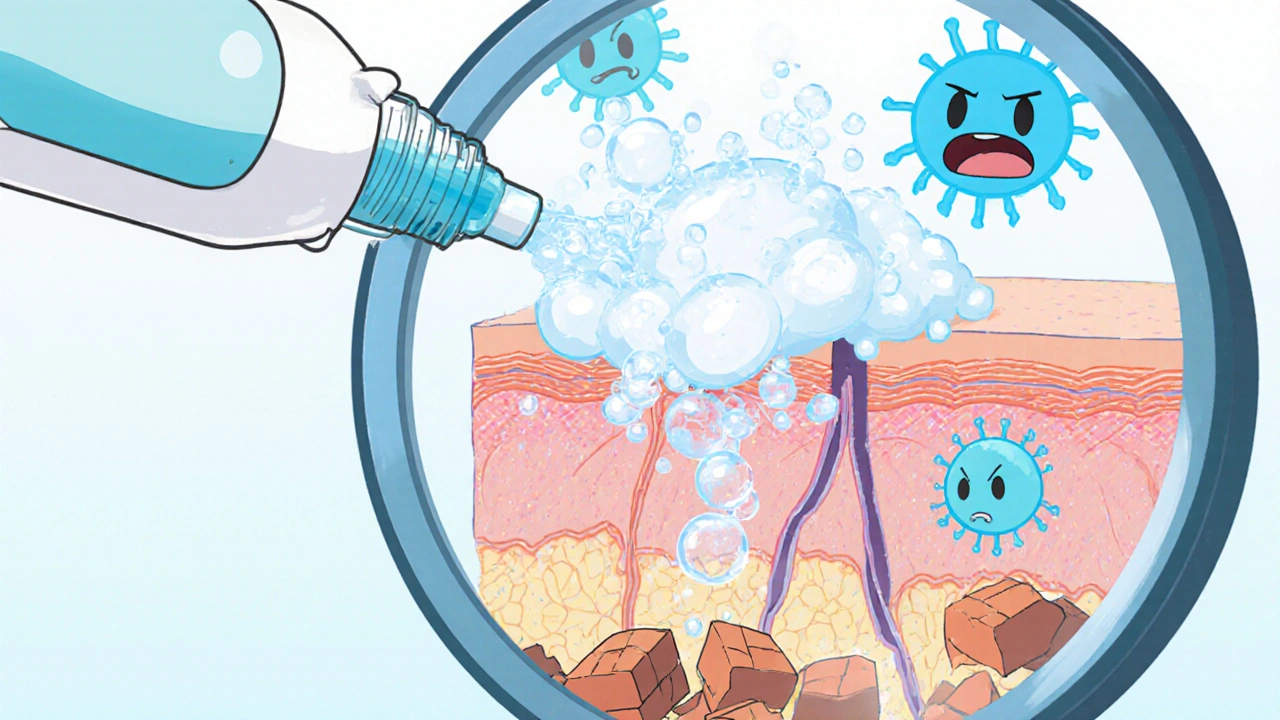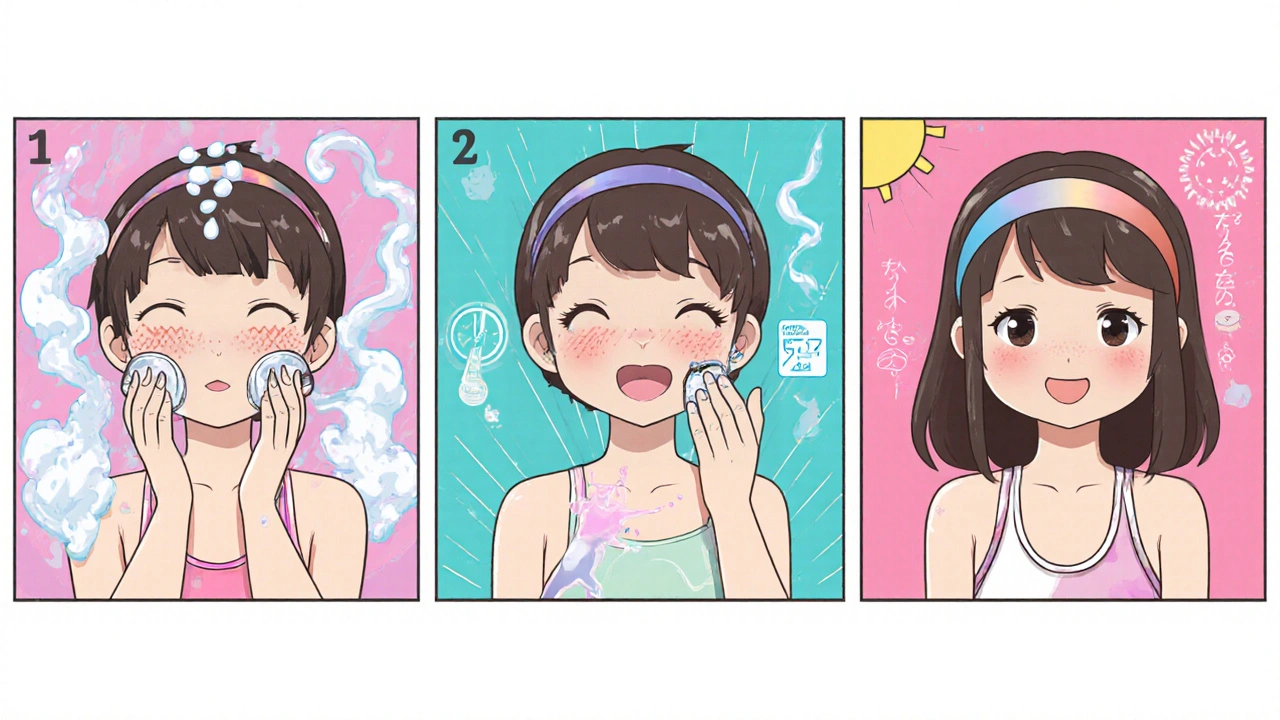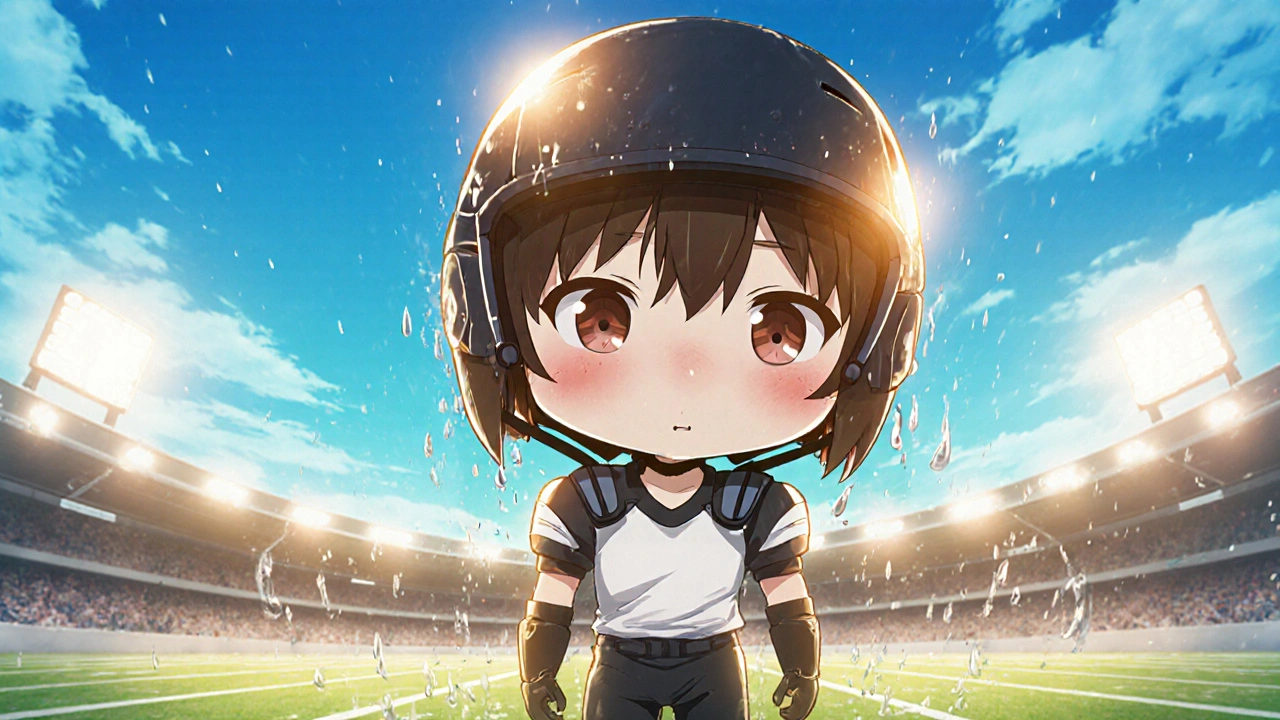Benzoyl Peroxide Treatment Calculator for Athletes
Personalized Acne Treatment Plan
Get the right benzoyl peroxide concentration and application strategy for your athletic lifestyle. Just answer a few quick questions to receive a tailored recommendation.
Your Personalized Recommendation
Based on your inputs, here's how to use benzoyl peroxide effectively:
When sweat, gear friction and intense training collide, many athletes find themselves battling stubborn breakouts. benzoyl peroxide is a tried‑and‑tested topical that can cut through the grime and calm inflamed pores, making it a go‑to solution for sports‑related acne.
What Exactly Is Benzoyl Peroxide?
Benzoyl Peroxide is a synthetic organic compound that releases oxygen when applied to the skin. The oxygen creates an environment hostile to Cutibacterium acnes-the bacteria that thrive in clogged pores and fuel acne lesions. The compound also helps shed dead skin cells, keeping pores clear.
Why Athletes Are Prone to Acne
- Excess Sweat: Heavy perspiration mixes with natural oils, creating a breeding ground for bacteria.
- Friction From Gear: Helmets, shoulder pads, and tight workout clothes constantly rub the skin, causing irritation and blocked pores.
- Hormonal Swings: Intense training can trigger hormonal fluctuations that increase sebum production.
- Supplement Use: Some athletes take anabolic steroids or high‑protein supplements that can aggravate acne.
How Benzoyl Peroxide Helps the Athlete’s Skin
- Antibacterial Action: By delivering free‑radical oxygen, it kills Cutibacterium acnes without harming surrounding tissue.
- Keratinolytic Effect: It loosens the “glue” that holds dead skin cells together, preventing them from clogging pores.
- Anti‑Inflammatory: Reduced bacterial load means less redness and swelling, which is crucial when athletes need to look presentable on camera or during interviews.
- Quick Drying Formulas: Most gels and creams dry within seconds, so sweat won’t turn the product into a slippery mess during a match.

Choosing the Right Formulation for Sports Life
| Product | Typical Concentration | Mechanism | Pros for Athletes | Cons |
|---|---|---|---|---|
| Benzoyl Peroxide Gel | 2.5%‑10% | Oxygen‑based antibacterial + keratolytic | Fast drying, non‑comedogenic, works on oily skin | May cause temporary dryness or peeling |
| Salicylic Acid Lotion | 0.5%‑2% | Exfoliates via beta‑hydroxy acid | Gentle, good for sensitive skin | Less effective against bacteria, may need higher frequency |
| Retinoid Cream (Adapalene) | 0.1%‑0.3% | Cell turnover accelerator | Prevents new lesions, useful for maintenance | Can increase sun sensitivity; slower onset of results |
For most athletes, a 2.5%‑5% benzoyl peroxide gel applied once daily strikes the best balance between potency and tolerability. Higher concentrations are reserved for stubborn nodules but often bring more irritation.
Step‑by‑Step Application Guide
- Cleanse with a gentle, sulfate‑free face wash. Rinse with lukewarm water to open pores.
- Pat skin dry with a clean towel. Avoid rubbing, which can already irritate the skin.
- Apply a pea‑size amount of benzoyl peroxide gel to the affected area. Spread thinly; more isn’t better.
- Let the product dry completely (usually 1-2 minutes) before putting on helmets, headbands, or training gear.
- If you’re sweating heavily during a workout, consider a “re‑apply after shower” routine: cleanse, re‑apply, then let dry.
- Moisturize with a non‑comedogenic, fragrance‑free lotion to combat dryness. Look for ingredients like ceramides or hyaluronic acid.
Managing Common Side Effects
Even the most resilient athletes may notice mild irritation. Here’s how to keep it under control:
- Dryness or Peeling: Reduce application to every other day for the first week, then gradually increase.
- Redness: Choose a product with a lower concentration (2.5%) and pair it with a soothing moisturizer containing aloe or niacinamide.
- Stinging on Cuts: Avoid applying on fresh abrasions or shaved areas; wait until the skin heals.

Complementary Strategies for Clear Athlete Skin
Topical treatment works best when paired with good hygiene and lifestyle habits:
- Shower Immediately After Training: Remove sweat and bacteria before they settle.
- Clean Gear Regularly: Wash helmets, headbands, and pads weekly to limit bacterial buildup.
- Wear Breathable Fabrics: Moisture‑wicking materials reduce friction and keep skin drier.
- Watch Your Diet: Foods rich in omega‑3 fatty acids (salmon, walnuts) can lower inflammation.
- Stay Hydrated: Adequate water intake supports skin barrier function.
- Consult a Dermatologist: If lesions persist after 8‑12 weeks, professional guidance may be needed.
Frequently Asked Questions
Can I use benzoyl peroxide on my whole face?
Yes, but start with a small patch (like the chin) to see how your skin reacts. If no irritation appears after three days, you can expand to the rest of the face.
Is benzoyl peroxide safe with sunscreen?
Absolutely. In fact, because benzoyl peroxide can increase sun sensitivity, applying a broad‑spectrum SPF 30+ sunscreen each morning is recommended.
Will it stain my sports equipment?
Most modern benzoyl peroxide gels are formulated to be non‑staining, but let the product dry fully before putting on any gear. If you notice a faint yellow tint, rinse the area with water before dressing.
How long before I see results?
Most users notice reduced redness and fewer new pimples within 1‑2 weeks. Full clearance of existing lesions can take 4‑6 weeks.
Can I combine it with other acne meds?
Yes, but stagger applications. For example, use benzoyl peroxide in the morning and a retinoid at night to avoid excess irritation.
Bottom Line for the Active Lifestyle
Acne doesn’t have to sideline an athlete’s performance or confidence. By understanding why breakouts happen on the field and applying benzoyl peroxide correctly, athletes can keep their skin clear without compromising training routines.

12 Comments
Ron Lanham
There is a moral imperative for athletes to recognize that the skin they display is not merely a superficial concern but a reflection of disciplined self‑care. Benzoyl peroxide, when used responsibly, becomes a tool of personal stewardship rather than a quick fix. The oxygen it releases is a metaphor for the clarity that comes from hard work and consistency. By committing to the prescribed regimen, one honors the effort they pour into training and respects the teammates who look up to them. Ignoring proper skin hygiene while chasing victories signals a careless attitude toward one's own body. The friction from gear is a reminder that the environment is unforgiving, demanding proactive measures. Applying a pea‑sized amount avoids the temptation to over‑dose, which would betray the principle of moderation. The drying time of modern gels aligns with the urgency of athletic schedules, allowing swift transition from shower to practice. Moisturizing afterward demonstrates that strength includes nurturing, not just aggression. The risk of dryness and peeling is not a flaw in the product but a lesson in patience and adaptation. Athletes who endure brief discomfort for long‑term clarity embody the very spirit of perseverance. The recommended concentration of 2.5‑5% balances potency with tolerance, preventing reckless experimentation. Higher concentrations should be reserved for severe nodules, echoing the need for measured escalation. Each application should follow a gentle cleanse, reinforcing the ritual of preparation before competition. In sum, the disciplined use of benzoyl peroxide mirrors the disciplined training routine, and neglecting either betrays the athlete’s commitment to excellence.
Deja Scott
Keep the gel fully dry before slipping on helmets or pads to avoid streaks.
Natalie Morgan
Benzoyl peroxide works by flooding the pore with oxygen which the acne bacteria cannot survive it also helps shed dead skin cells keeping the pores clear it’s fast drying so sweat won’t make it slosh around just apply a pea size amount and let it set before you gear up
Mahesh Upadhyay
Overusing benzoyl peroxide can cripple the skin barrier. Stick to every‑other‑day in the first week. Gradual increase prevents the peel that looks terrible on camera.
Demetri Huyler
Honestly, the “quick fix” hype around peroxide is overrated. Real athletes need a regimen that respects their schedule, not a gimmick that stains gear. Choose a formulation that dries in seconds and watch the difference.
jessie cole
Coach’s tip: after applying the gel, wait the full two minutes before you suit up. This simple pause ensures the product sets and won’t run into the eyes during intense bouts. Follow up with a light, fragrance‑free moisturizer to keep the skin barrier happy. Consistency is key, not a once‑in‑a‑while sprint. Your performance on the field will reflect the care you put into this routine.
Kirsten Youtsey
The industry pushes benzoyl peroxide as a miracle, but they hide the fact that it can increase sensitivity to sunlight. Many athletes ignore the need for sunscreen, leading to long‑term damage. It’s a classic case of profit over health.
Matthew Hall
What they don’t tell you is that the “non‑staining” claim is a myth. The yellow tint can show up on dark helmets after a single use. It’s a hidden agenda to keep athletes buying more product.
Vijaypal Yadav
Benzoyl peroxide decomposes into benzoic acid and oxygen upon contact with skin. The released oxygen disrupts the anaerobic environment that Cutibacterium acnes thrives in. Its keratolytic action loosens intercellular bonds, facilitating exfoliation. Concentrations above 5% increase the risk of irritant dermatitis without proportionally improving efficacy. For most athletes, a 2.5% gel provides optimal balance between antimicrobial activity and tolerability.
Rajesh Myadam
I understand the frustration when skin reacts. A gentle moisturizer with ceramides can soothe the irritation. Keep monitoring and adjust the frequency as needed.
Andrew Hernandez
Respectfully, the key is consistency and proper drying before gear. This simple step often solves the staining issue.
Alex Pegg
While many praise benzoyl peroxide, studies show a subset of users develop resistance over time. Consider rotating with salicylic acid to maintain effectiveness.